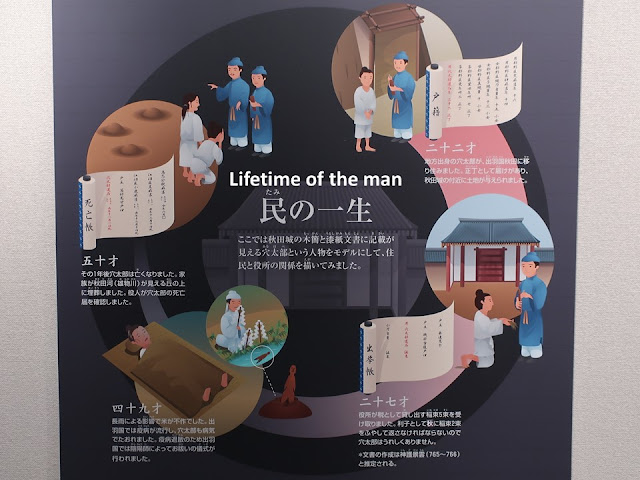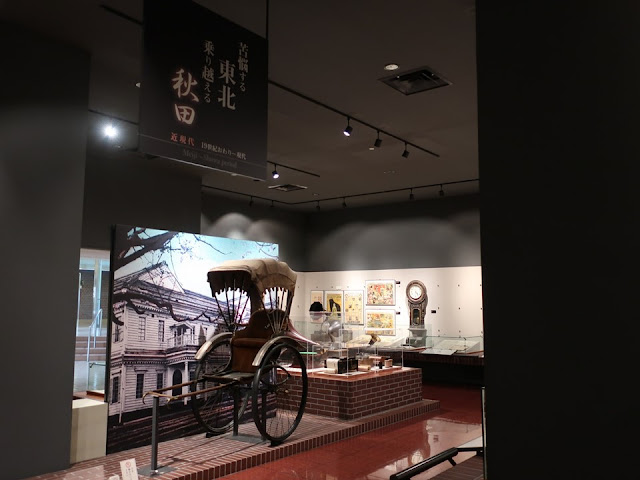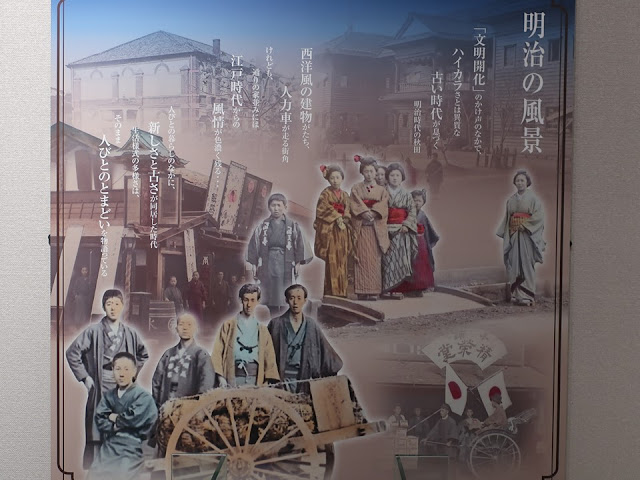In this article, I'll introduce exhibits of the historical period when humans could record their activity in Akita which is located in northern Japan. Photos were taken under the approval of the museum office. (Part 1 is about the prehistoric period)
Part1は、先史時代。Part2では、文字がある歴史時代の展示を紹介します。許可を得て撮影しました。
There was a man called Anatarou in the 8th century. His life was recorded in wood strips and paper. He suffered from a bad crop and an epidemic. Although Onmyouji (diviner) purified him, unfortunately he died the next year. He was fifty at that time. We can know the lifetime of an ordinary person. Records tell us a lot!
一般人の穴太郎さんの一生が木簡と漆文書に記されています。凶作、疫病の流行で病に倒れた穴太郎さんに、陰陽師によるお祓いが行われました。しかし、甲斐なく、翌年、亡くなりました。50歳でした。8世紀の話ですが、普通の人の生活がわかります。記録があるのがスゴイですね。
The wooden lunch box is displayed; it is popular even until now. People in the 8th century also enjoyed picnic probably. Btw, the central government tried to control Akita. On the other hand, Akita continued interacting with overseas.
「曲げわっぱ」は、奈良時代にはあったのですねえ。お弁当で日々を楽しめていたはず。一方で、大和朝廷と争い、調和する時代が続きます。朝廷は蝦夷に禄を与えるなどの柔和策をとりました。海外との交流も続きます。
Medieval period、中世
The theme is “Local regions were divided, but the nation was being unified.”
「分裂する地域、統合へ向かう国家」がタイトルです。
Suzaki site in Hachirougata which faces the Sea of Japan is considered as the hub of sea transportation, because many houses were excavated.
八郎潟の洲崎遺跡からは、大規模な住居跡が多数発掘され、水上交通の拠点だったことが分かりました。
The fish-shaped person was drawn on the wood strip. Did it exist?
発掘された人魚木簡。絵が描かれていて、いい感じです。
Although the history of samurais in Akita is shown well, I chased exhibits of human lives as usual.
武士団の動向など、歴史もしっかり展示されています。が、私は、引き続き、人々の暮らしを追います。
Edo period、江戸時代
From the early 17th century to the end of the 19th century、17世紀初め~19世紀終わり
The theme is “Matured society, vivid people”. The ordinary people are highlighted, though the history has also explained well such as Satake Clan who moved to Akita in 1602.
テーマは「成熟する社会、躍動する庶民」。庶民に光りを当てています。もちろん、1602年、常陸国(茨城県)から秋田に転封した、佐竹氏についてもしっかり展示しています。
“I-Ro-Ha cups” are very interesting. “I-Ro-Ha” is equivalent to “A-B-C” in English. There are various volume of cups which is marked “I”, “Ro” and so on. “I-Ro-Ha” tags are put into the small container (lower left). It is shaken, and a tag is pulled out. It shows the cup which you must use to drink sake (alcohol). I saw it for the first time. These were owned by a middle-class samurai, Onuki family.
People wanted to drink a lot or wanted someone to do so, I’m not sure. But I’m sure it was a fun time. There is similar set in Yuzawa, Akita; people play with Geisha girls.
中級武士(94石)、小貫(おぬき)家の諸道具の中に、「いろは盃」がありました。容量が異なる盃に、いろは、の印を付けています。いろはの札(写真下中央)を、左下の器に入れて振り、出た札に相当する盃で酒を呑みます。はじめて見ました。
たくさん呑みたいのか、呑ませたいのか、楽しいひとときだったと思います。
銀山で栄えた秋田市湯沢には「きのこ杯」があり、キノコ型の漆器を分解すると、大小の盃とサイコロになり、同じように遊びます。お座敷遊びだったようです。FBで教えて頂きました。
Pots (upper) and Suzuri-bako which is a case for an inkstone (suzuri), an ink stick, writing brushes, etc. I can say these are not utensils but works of art.
鍋(上)と硯箱、こちらも芸術品です。
Hanami (Sakura blossom viewing) – Bento (lunchbox). Gorgeous people held the picnic.
花見弁当。豪勢な花見、ですよね。
Old books which were originally published in the 8th century are in the book shelf box. It is difficult for me to read; I respect the readers. The outfit on the left was for a firefighter.
中央は、古事記伝を入れた箱です。難文をよく読んだな、と思います。左は、火消し(とび)の装束。
The photo above is an Ema wooden board (replica) which was offered to the shrine. Sanou festival of Hiyoshi-Hachiman Shrine which is located in the merchant town is drawn. Surprisingly, the giant octopus, which catches a big fish, is on the float. They had a good sense of humor. Everyone in the drawing looks happy.
外町の総社・日吉八幡社の山王祭の大絵馬(復元)。外町は商人の町です。山車に海の幸が載っていると書かれていますが、それは魚を捕まえた大鮹です。えー。遊び心ですね。皆さん楽しそうな顔をしています。
Many vivid people are depicted in “Akita Fuzoku (local customs) Emaki (picture roll)” which was painted in around 1800. I felt the power of people, so I like this.
「秋田風俗絵巻」(1800年頃)に描かれた人々。絵馬と同じく、町人パワーを感じます。みんな生き生きして、良い絵です。
There is a public passage between the door and the house. It is useful in a snow season; the doors shut snow. It is called “Komise” and there are similar ones in this region.
Reference: Komise in Kuroishi、青森県黒石のこみせ
戸を閉めると雪を避けられる通路になる、「こ見世」の実物大モデルが展示されていました。弘前や黒石と同じ構造です。雪国ですね。
Surprisingly enough, a farmer enjoyed 211 day sightseeing tour in 1788. He was a wealthy farmer “Chouemon Sato”. He left his village on the 4th of March, and returned on the 8th of October. His aim was visiting Ise Shrine, but he also visited Nagasaki which is around a thousand kilometers west of Ise.
He wrote various matters in his travel diary: Basho’s poems which was carved on the stone monument, impressions of castles and so on. At Himeji Castle, he hired a guide. Btw, he moved every day. I guess he had to finish traveling until the snow season started. It was a once in a lifetime trip. Must be fun!
Reference (Haiku master, Basho): Basho memorial museum 芭蕉記念館
上層農民・佐藤長右衛門さんの1788年旅は、何と211日間(3/4-10/8)の観光旅行です。伊勢参りが目的ですが、長崎まで足を延ばしています。伊勢まででも遠いから、一度旅に出るとこのぐらい行かないと、ということでしょうか。
佐藤長右衛門天明八年道中記の翻刻版(雄物川町郷土史資料, 第27集)を拝見しますと、芭蕉の歌碑の俳句を転記したり、城についてのメモ(若山 紀伊中納言五十五万五千石 名城也など)を残したり、西国三十三ヵ所であることを記載したり、興味の広さを窺えます。姫路城では、ガイドをつけたようですよ。連泊せずに、頑張って旅をしています。雪が降る前に造山村(現横手市)に帰らないと。一世一代の楽しい旅でしだったと思います。
The photo above is the rankings list of mountains in Japan which is a same format of Sumo wrestler rankings table. The champion in the east Japan is Mt.Choukai (in Yamagata pref. and Akita pref,, altitude of 2,236m), and the one in the west Japan is Mt.Aso (in Kumamoto pref., 1,592m). Mt.Fuji (3,776m) is a referee.
There were also the rankings list of Onsen hot spring resorts and restaurants. Japanese people like rankings.
諸国名山番付:東の大関(トップ)は鳥海山、西の大関は阿蘇山、富士山は行事です。温泉番付、料理屋番付などたくさんの番付があります。日本人は番付好きです。
Passport、箱根関所に宛てた通行手形
The structure of the farmer’s society is shown. Farmers belonged to a community which was a village. They had a shared mountain to get firewood etc. and a shared river to obtain water. Of course, they maintained the land. They bought necessities in their castle town in which Han (local government) was.
農民は村という共同体の中に居て、山や川を共同利用し、城下から生活必需品を購入しながら、暮らしていました。分かりやすい絵です。
Akita is a snowy region, so they worked to remove snow in December and January.
12月から1月に除雪があります。
Farmers’ belongings are displayed. Han (government) often required farmers to be frugal. Therefore, those were simple but good products.
農民の道具。武家の道具ほどの華やかさはありませんが、良い品です。農民はいつも質素倹約を求められていましたからね。
Medicine box. The owner learned in Akita and got a license, then returned to his village and worked as a doctor.
玄眠の薬箱。秋田で医師に学び、医師の株を取得し、地元で医療活動を行った幕末の人だそうです。
Mountain works are introduced. People cut trees in winter, carried them by sled. In spring, they made a raft from trees and brought them to towns. It was a difficult work.
There are mines in Akita, workers came from
not only Akita but also Hokuriku and Chugoku regions. Life wasn’t easy.
山(鉱山と木材)の管理。木材は冬期に伐採してそりで運び出し、筏にして雪解け水で下流に送りました。厳しい仕事ですね。鉱山の堀子は、地元だけでなく、中国地方や北陸地方からも来ました。
Modern era (Meiji~Showa period)、近現代
After the samurai administration broke down, modernization started. Western culture such as a brick building appeared suddenly. It says, “People were confused.”
旧来の風景の中に、建物など西洋文化が入ってきました。「人々のとまどい」と書かれています。
Sugae Masumi Exhibition Center、菅江真澄資料センター
Sugae(1754-1829) was a travel writer and a pioneer of Japan folklore. He lived in Akita more than 25 years and recorded the local customs. We could know everything about him here.
菅江(1754-1829)は、旅行家であり、民俗学の祖と言える方です。秋田に25年以上滞在し、地誌を残しました。撮影禁止ですが、ここに来れば菅江真澄のことがほぼ分かると思います。
https://www.akihaku.jp/kannai/masumi/masumi.htm
(in Japanese, but around ten photos are unloaded)
Visited in October, 2020
Official website: https://www.akihaku.jp/english-page.htm
https://www.akihaku.jp/
(in Japanese, but much more info.), accessed in June, 2021
Previous post (part1 of this museum):
Akita
Prefectural Museum (1/2)、秋田県立博物館(1/2)
Next post (Akita
is where the popular dog originated):
Akita (breed of dog) museum、秋田犬博物室






























Comments
Post a Comment